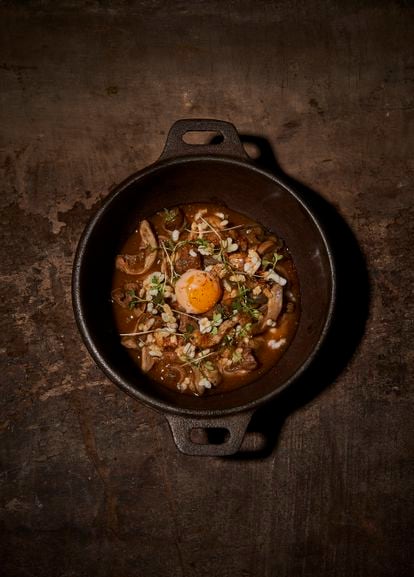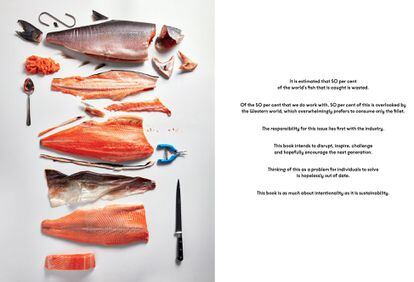Spain is a land of sausages, noble meats and rich delicacies made with the noblest parts of the animal, what they call offal. It was not so long ago that in certain neighborhoods of Madrid you could still see small establishments whose façade read: “Language and Talent Office.” That is to say, tongues, brains and other beloved delicacies were sold there.
The tripe, the zarajos, the gallinejas, the ins and outs, the liver, the rooster's combs, the heart… and in extension, the black pudding, the chorizos, the meat and fish sausages are part of our history and, today Today, the stalls selling such noble bites, unfortunately, are disappearing. “In the offal shop window there are few cuts that offer the buyer a bloody, slimy or unpleasant appearance. —wrote Abraham García in his desired book Guts Heart—What's more, even the stomachs, impeccably clean as they are sold today, have a strange attraction with their pearly arabesques that simulate a lunar landscape. This book is, even today, the best hymn to the world of the ins and outs, a placid piece of writing halfway between literary narration and the wildest recipe book, the most beautiful and appetizing ode to dishes with blood, lamb heads. or wild boar testicles. “There has been a manifest contempt for offal when the first recorded recipes already mentioned offal. In Greco-Roman cuisine they were a delicacy, but now even the language, their own name, offal, despises them,” the cook continued in his book.
Offal, discards, “sometimes also called offal and often considered to be just viscera,” writes Nichola Fletcher in the book Meat, edited by DK. “However, these delicacies comprise a very diverse set of flavors and textures. It is true that some are viscera, such as the liver, kidney and heart (which, together, are also called offal); but offal can also be the legs, tail or head and others could be described as carcass discards, such as bones, fat and membranes,” he continues. The book is a manual to master cuts, perfect techniques and start cooking because more than 300 recipes are distributed inside. There is a chapter in the book dedicated entirely to the remains. “Most offal is rich in nutrients and essential fatty acids, and low in harmful fat,” the author writes before giving way to a photographic display of livers, hearts, kidneys, intestines, brains and other delicacies. The edition is very good, with step-by-step photographs and very tempting plating.
What we could call the cuisine of organ meats has been, throughout history, a varied and praised delicacy. From the Egyptians, the Romans, the Greeks… through Asian cultures (many writers have come to call Asia the mecca of cooking with offal), the liver, the criadillas or the head have been the main ingredients for a cuisine noble and appreciated. However, it is difficult to find books that pay tribute to these 'other meats' of terrestrial or marine animals. Said Guts Heart. The bible of offal, by Abraham García, published in 2009 by Planeta, was never republished and is possibly the most sought-after book among gastronomy professionals today. Over time, chef Javi Estévez, from the La Tasquería restaurant, published a book with the recipes from his restaurant, offal (Montagud Editores), where he showed his kind view of the ins and outs of this cuisine, managing to place it among the favorites of even those who believe that they would never eat, to name some of his dishes, a brain omelet, a cheek sandwich or a tongue with snails Don't look for it, it's also discontinued.

What leads an editor to decide to publish a book or let it get lost in that black hole of forgotten books? Who knows. What booksellers do know is that there are themes that are not editorial bets because they are not fashionable or because they would be a book for minorities. In other cases, not even editors can absorb so much writing. In 2014, an American author, Jeffery Weiss, arrived at the Madrid Fusión international exhibition with his book under his arm: Charcuterie. The Soul of Spain (published in Chicago by Surrey Books). He arrived wanting someone in Spain to listen to him, see the voluminous and well-edited book, and decide to publish a version in Spanish. He didn't get it. The book, which has a foreword by Jose Andrés, can only be purchased in English and, of course, is one of the best sausage manuals written so far. In a way, this book pays tribute to this tradition, in the same way that the photographer, Eduardo Torres, and the sociologist, Pablo Torres, have done. Both have given shape to a beautiful book, full of emotion, called Butchers by trade, from the Argentine publishing house Catapulta. “This is a tribute to those men and women who dedicated their lives to the practice of butchery,” write the authors of the book. Thus, they give a nostalgic and well-deserved recognition to 15 professionals and, along with that applause, they sprinkle the recipes such as braised tongue, cauliflower and Chinese broccoli puree, stewed tail with polenta and turnip greens, brains, ham and cremona.

Possibly, in this line of admiration and applause for such an ancient craft, and even for the artistic and literary inspiration that they could generate, the books were born. Graphic Meats. A co-edition of Addictions Becauses and Typerepublic. The first edition was published in two colors: on the illustrations side, in a single red ink; and on the other side, where seven stories inspired by the world of butcher shops were collected, in black ink. Both editions are collectors' material.

But when we talk about discards, waste cooking or noble stews, we are not only referring to the world of meat. The bowels of the sea have been the main protagonists of recent years. The work of chef Ángel León is a good style manual on how to work with sea discards to make dishes with them like his Sea Sobrasada or Tuna Heart Morcilla, for example. These dishes, which were part of his bet in the kitchens of Aponiente, were gathered in another book also out of print and edited by Montagud, The Chef of the Sea.

What we throw away or what we clean from a fish, what to do with it? How to use those discards that can become Michelin star dishes? Maybe to get an idea you will have to acquire the book Fish Butchery by Josh Niland, for now only in English, although in October it will be released in Spanish by Planeta Gastro, an essential manual for those who love the world of the sea in all its expression. Sure, the book of the year.
#cuisine #viscera #hearts #tongues #brains #delicacies #offal
